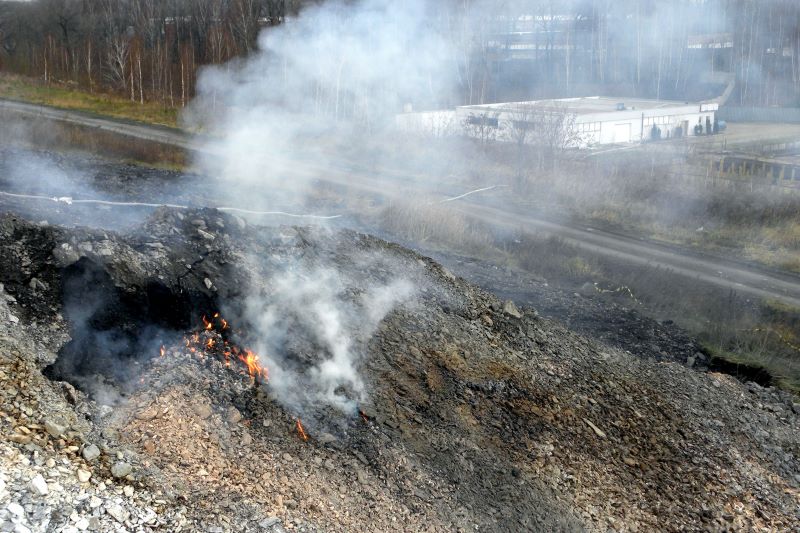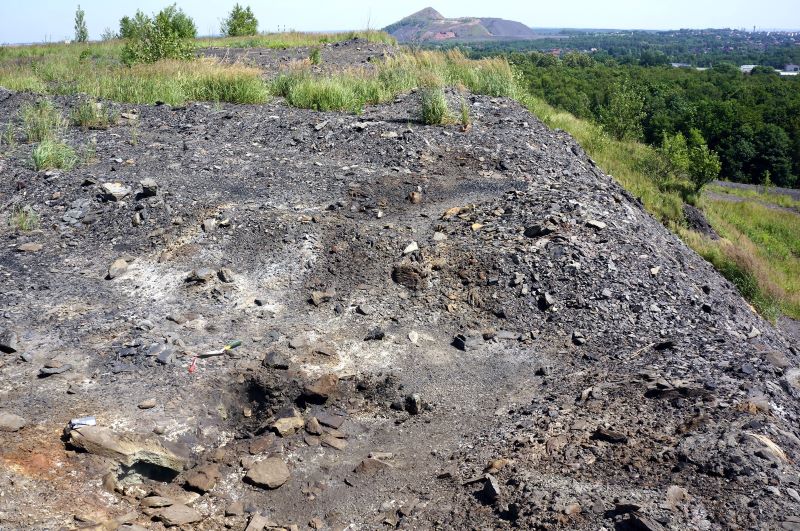We keep mass polluting the environment contributing to the destruction of the natural environment and risking our health and lives. Post-mining waste heaps are an important problem for Silesia, and even though these issues need to be solved, there is a lack of concrete ideas. How to bring nature and civilisation together? Can it even be done?
Contact
Justyna Ciesielczuk, PhD, DSc, Associate Professor (justyna.ciesielczuk@us.edu.pl) and Prof. Monika Fabiańska (monika.fabianska@us.edu.pl) from the Institute of Natural Sciences of the University of Silesia
| Weronika Cygan |
Most likely, there isn’t any place on Earth untouched by humans, intact and unexplored. We have left our mark everywhere, significantly influencing the environment around us. We are constantly finding plastic in the deepest and highest places on Earth, and its particles are scattered on the uninhabited areas of the Arctic. However, nature is an incredibly creative and resolute architect — it can come to life even in the most unpleasant conditions.
One of the most recognisable elements of the Upper Silesian landscape is the post-mining waste heaps — remnants of coal mining — which are connected with the region’s industrial heritage that the community struggles with to this day. These sites, known to contain a mixture of toxic substances (often difficult to identify) and prone to fire, are sometimes also extremely biodiverse. Given sufficient time, the mining waste storage sites that scare away any potential passersby can turn into the so-called green islands with spontaneously developing wildlife.
Fire on the waste heap slope in Katowice-Wełnowiec (2010) | Photo: Justyna Ciesielczuk
The inferno of Wełnowiec
In Wełnowiec, a district of Katowice adjacent to Siemianowice Śląskie, there is a former waste dump remediated using waste from coal mining. Its dynamic ecosystem, consumed by fire on multiple occasions, has been the subject of research by Justyna Ciesielczuk, PhD, DSc, Associate Professor and Prof. Monika Fabiańska from the Faculty of Natural Sciences of the University of Silesia for a dozen or so years.
The scientists argue that all attempts to remediate the land failed to produce the desired effects and the nature fairs better at populating the heap all on its own, without human intervention. The excess of coal waste used during the remediation contributed to triggering self-heating of organic matter, culminating in a heap fire. As a result, harmful substances made their way into the environment. The air, water, and soil were contaminated.
‘As a result of the ongoing firefighting operations on the northern slope of the site, the fire disappeared a few years ago and there are now plans to create a park in the area. Previously, for more than a dozen or so years, it was a place where jogging or taking your dog for a walk were strongly discouraged’, says Prof. Justyna Ciesielczuk.
Hikers should also be alarmed by the relatively high concentrations of carbon monoxide, reaching up to 3% in 2011, which is a lethal dose for humans. One comforting fact is that such high concentrations were recorded only right by the ground.
Scientists from the University of Silesia warn us about the risks associated with self-heating of coal mining waste and the possibility of a repeat fire. Since the processes taking place at the waste dumps are chaotic and influenced by a variety of factors, it is difficult to predict when, or if, a fire could start again. The presence of organic matter, which is an excellent fuel, or bacteria, whose life processes generate heat, can be of significance here. Other characteristics, such as the shape of the land and the direction of wind, are also important. The researchers point out that it would be a challenge to find an old mining waste heap not affected by fires in Upper Silesia.
An all-you-can-eat buffet
‘The process of spontaneous vegetation overgrowing the heap in Wełnowiec is interesting. In between the self-heating incidents, it spontaneously gets covered in beautiful, often lush vegetation, which would entice local residents to treat it as a green space where you can take a walk or ride a bike’, says Prof. Monika Fabiańska.
The researcher explains why this seemingly hostile place is so attractive for certain species of plants, although mainly those with particular environmental requirements. Many of them are endangered and listed in the Polish Red Book of Plants. Only the species which can withstand high temperatures, the presence of heavy metals, and the small amount of water seeping through the heavily permeable ground stand a chance of survival. The high temperature of soil, reaching up to 20-30°C in the winter, is favourable to them, allowing year-round growth.
‘The growing season is completely disrupted here. We observe seedlings, blooming plants, and fruiting plants of one species all at the same time. In moderate climate it is impossible’, explains Prof. Justyna Ciesielczuk.
The plants are also attracted to the abundance of nutrients, i.e. carbon dioxide and large quantities of nitrogen created in the process of self-heating. Such good growth conditions result in frequently-observed gigantism among plants growing on heaps: representatives of a given species several times larger than usual are quite a common sight. The researcher mentions her own observations of Atriplex nitens, which reached a height of two metres at the waste dump in Wełnowiec. The scientific literature states its maximum height to be around 1.2 metres.
Foreground: thermal activity of the Anna heap in Pszów, background: Szarlota — the largest waste heap in Upper Silesia | Photo: Justyna Ciesielczuk
Unique ecosystem
Some of the peculiar characteristics of the mining waste heaps’ ecosystem can be seen at first glance. In Wełnowiec, the scientists witnessed the occurrence of the so-called first coloniser rule. A unique arrangement of plants, laid out in distinctive rows, appears in a burntout area. One row is populated by one species exclusively — the one that is the first to grow in an area free of competitors. This phenomenon is caused by the heating of the ground, which eliminates the natural seed bank.
The variety of plant species also often attracts other organisms. Prof. Monika Fabiańska mentions the results of research conducted in Czechia in 2013: ‘There were many endangered species found at the mining waste dumps, including beetles, insects, birds of prey such as kestrels, buzzards, as well as many rodents. The ecosystem is disrupted, but interesting’
Waste dumps, which as a general rule are places unfriendly to humans and rarely visited by them, provide favourable conditions for many animals to live and to raise their offspring. When left undisturbed by humans, they can live relatively quiet lives.
Green islands
Since nature is so skilful at managing heaps, the question arises whether attempts to remediate mining waste dumps are indeed the optimal measure. Such initiatives require sizable budgets, while their results are often disappointing.
Prof. Monika Fabiańska, invoking again the analyses conducted by our neighbours south of the border, argues that human interference may prove counterproductive. The Czechs noticed that the unremediated heap was richer in various organisms than the remediated one. Once the soil had been topdressed, other species were also introduced, resulting in a complete metamorphosis of the area. A small amount of grass was struggling to maintain itself and bushes were barely holding on.
The fact of nature recovering at the heaps alone is not enough to consider those places safe for humans. The risk of fire, even after many years of relative calm, is not the only thing we should be concerned about, because toxic substances can still accumulate in the deeper layers of waste. This is why the idea to create a park in such a place as the heap in Wełnowiec remains controversial.
‘In my opinion, it is not a good idea to let people enter such areas. There is always the danger that a self-heating process will start somewhere and we won’t notice it and the people in the area could be exposed to harmful emissions. I would recommend keeping people away from waste dumps’, says Prof. Monika Fabiańska.
The solution recommended by the researchers would involve leaving such places as green islands where nature develops spontaneously.
Giant, exuberant Atriplex nitens (łoboda błyszcząca) in the part of the heap extinguished in 2009 (Wełnowiec) | Photo: Justyna Ciesielczuk
Civilisation and nature
But what should be done with the waste left behind at the dumps? Could some of it be re-used?
A long-standing lack of monitoring is not an uncommon occurrence. It causes difficulties in finding out what quantities and what kinds of toxic compounds end up in the dumps today. In many cases, this problem was inherited from the 19th century mine owners, who weren’t concerned with preserving the environment. We did not become aware of the dangers of excessive coal extraction and improper storing of waste until a century later.
The matter is further complicated by the fact that waste heaps may have been used by different owners over the decades, and in many cases the records have either been lost or they have not been kept at all. This is why we should remain cautious when considering ideas to re-use materials obtained from mining waste heaps. However, it is not entirely out of the question. Prof. Justyna Ciesielczuk mentions road construction and the use of materials that have already been burned out in a heap fire as an example of proper ‘recycling’. Environmental transformation — first by humans and then by nature — constitutes a proof of the power of nature and, at the same time, displays the limits of its flexibility and resilience.
The vision of imminent battle between civilisation and nature, in which one side always loses, does not have to come into fruition. Cooperation is possible, as Prof. Justyna Ciesielczuk points out with complete confidence.
‘We have to remember that although humans created civilisation, they still remain a part of nature. We just need to understand it a little better. Nature can benefit from our activity and we can collect the fruits borne by it’.
The article entitled ‘Second life of waste heaps’ was published in the No Limits no 2(8)/2023 popular science journal of the University of Silesia.








